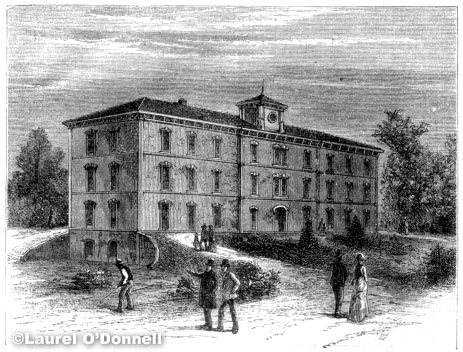|
|
 The Workshop
I had not spent many days in the institution before I awoke to the fact that the sign language is an exceedingly curious and attractive matter to study. Though I had elsewhere witnessed some slight exhibitions of its pantomimic story-telling, and had even been taught a few of its terms — if I may call them so — it was rather startling to discover here a complete language, adequate to all sorts of ideas, with which words have nothing to do. It is no more English than it is Chinese. Its signs represent objects, actions, qualities, and whatever else words express; but they do not represent words. Many people fancy it to be merely a shorthand way of talking, signs being interspersed here and there just to save the trouble of spelling out all the words. Doubtless it does save trouble; but that is not the main thing. Signs can make their way where words can not. They go before words; they prepare the way for them; they rouse the unconscious soul; they bring candles into its dungeon; it bestirs itself at last, and cries for the light of day. When words begin to be admitted, signs introduce them; and not until the expanding intellect has grown beyond its childhood does the sign language at length withdraw from the scene, and give place to the language of words. At table I used to notice the lively conversations carried on by the mute teachers between themselves. Some of them scarcely needed interpreting, since the expression of the face supplied a key. The grand principle of signs being resemblance, they are not very difficult to comprehend when they refer to visible objects and acts, or to simple emotions. Beyond this the uninitiated are apt to find themselves in the dark, unless there is somebody to interpret. For example, the sign for "Quaker" is made by twirling the thumbs about each other, the fingers being loosely interlaced. "Humbug" is intimated by extending the right hand upon the back and extended fingers of the left, while the thumbs are wagged — sarcastically, no doubt — upon either side If you wish to allude to what is called a "courting," you interlace the fingers so that their tips are toward you, and the tips of your bent thumbs about an inch apart; then wag the thumbs slightly, as if the happy pair were nodding and chattering in a cozy tête-à-tête, and you will be struck with the aptness of the representation. One day, happening to inquire whether it were possible to express in sign language the grammatical modifications of mode, tense, etc., Professor Cooke did me the favor to summon a very intelligent pupil in the collegiate department, named Jones, to give illustrations. He immediately represented various forms of a given verb, in each instance naming the mode, tense, person, and number with great precision. I am sorry that I can not recollect how to make, for instance, the third person singular, pluperfect subjunctive, of the verb to write, in sign language at I was glad to learn that upon a pinch the thing can be done. In point of fact, however, I presume it is not always done. Some of these grammatical accidents may very well be left for the imagination to supply. Page 13
These pages are © Laurel O’Donnell, 2006, all rights reserved Copying these pages without written permission for the purpose of republishing in print or electronic format is strictly forbidden. Books & articles appearing here are modified adaptations. This page was last updated on 01 Jul 2006 |
